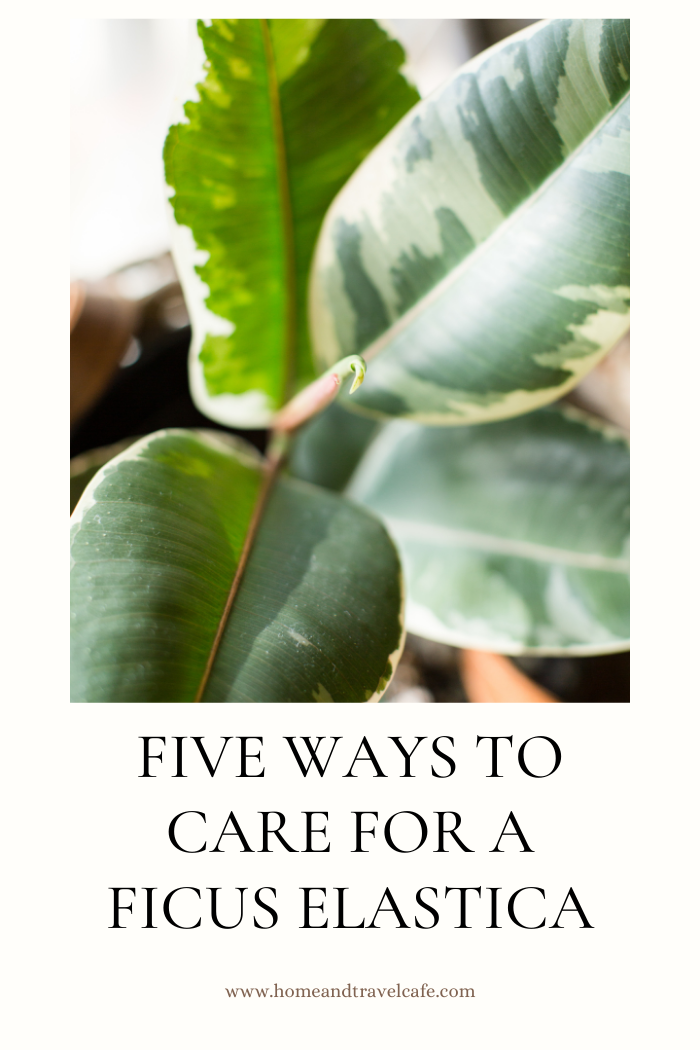Today we want to share with you how to care for a ficus elastica if you’ve added it to your house plant line up. The Rubber Fig has grown in popularity over the last four years. Almost all garden centers carry some specimen of this plant. With deep green leathery foliage, the Ficus Elastica makes for a stunning houseplant.
Ficus Fact: The ficus elastica belongs to the fig family, Moraceae; it was used for its latex sap to make rubber before synthetics were made available.
By Sargam Merchant.
For Home & Travel Cafe by Linette.

Looking to buy? Ficus Elastica Plants on Amazon
How to care for a ficus elastica
Known for its large, leathery leaves, this tropical houseplant is a statement piece for any plant lover’s home. If I could use one word to describe caring for this tropical, I’d say ‘easy’. This houseplant requires low maintenance and care; it is minimally fussy, mess-free, rarely sheds, and unlike some other finicky houseplants (cough fiddle-leaf figs), the rubber plant adjusts quickly to different environments. Here are some simple tips to keep your ficus thriving.
How to care for the leaves of a rubber fig
The most attractive feature of this ornamental is its foliage. The signature of the rubber plant is its glossy leaves, ranging from an almost raven green to olive, sometimes variegated with pink and cream.
The best way to monitor the health of your ficus is to observe its leaves. A plant that is stressed will display browning, discoloration, or drop its leaves.
The beauty of the rubber plant is in its foliage; use a soft microfiber cloth dipped in water to wipe the leaves every other week.
Grow Tip: For extra gloss, use a mixture of equal parts full-fat dairy milk and water; use this to wipe the leaves once a month.
How to care for the nutritional needs of your ficus:
The rubber plant prefers a brightly lit space. Place it five to eight feet away from direct sunlight, avoid keeping your plant immediately next to glass windows or vents.
You can feed your rubber plant with a 10-10-10 fertilizer during the spring and summer months.
Grow Tip: If you enjoy sipping on tea, consider sharing the leftover grounds from your teabag with the rubber plant. Gather 100% natural tea bags together, air dry, add to the soil of the rubber plant once every three months.
How to care for the roots of a ficus elastica:
The rubber fig prefers well-draining, aerated soil; if you are preparing the potting, mix yourself, use a combination of one part peat moss, one part perlite, and one part potting soil.
Grow Tip: Refresh the soil by topping it with new soil and potting mix every spring.
When planted in a pot, the roots of the rubber plant grow slowly. This plant needs to be re-potted once every three years. Repot in the summer months; make sure to use a pot that’s only one size bigger than the pot the plant is currently inside.
Grow Tip: Airate the soil every six months by gently poking several holes in the soil using a skewer or chopstick.
How to care for the moisture requirements of a ficus fig:
One of the significant setbacks new plant parents face with the rubber plant is disease caused by overwatering.Excess water can cause the rubber plant to drop leaves and develop root rot.
Make sure your pot has sufficient drainage holes, water the plant when the soil is dry to touch.
Grow Tip: For a quick DIY moisture test, insert a chopstick into your rubber plant pot; if the bottom of the chopstick comes out wet, your plant might need a light watering; if it comes out dry, water the plant thoroughly.
The rubber plant is tolerant to lower humidity levels; mist the leaves on hot evenings to give your plan a little TLC.
How to care for a sick rubber fig:
If your rubber plant has been infested with pests like mealybugs or spider mites, a three-pronged pest control plan is the best treatment.
Tip the plant to its side and give it a thorough wash; this will prevent overwatering and minimize the chances of pests entering the soil. Once the plant is dry, spray the front and back of the leaves with a mixture of dish soap, water, and neem oil. Keep the plant away from direct light and add Bonide systemic insect control to the potting mix, water thoroughly.
To prevent reinfestation, spread diatomaceous earth on the soil, inspect leaves and stems regularly, and apply systemic treatments as needed.
We hope you enjoy caring for your rubber plant with this simple care guide. If you have any tips for our readers, let us know in the comments below.

 Follow
Follow